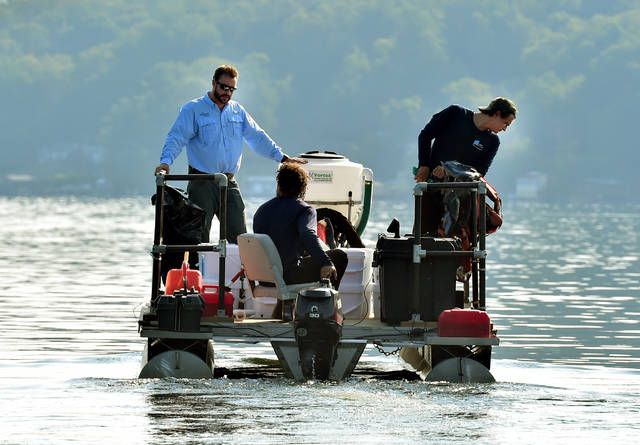Click here to subscribe today or Login.
HARVEYS LAKE — The days are numbered for the hydrillas taking root in Harveys Lake.
Borough council, its Environmental Advisory Council and Princeton Hydro, an ecological and engineering consulting service, started an eradication program to remove the evasive aquatic plant Thursday morning.
At 8 a.m., Fred Lubnow watched his team set out in a pontoon boat carrying 2,180 pounds of a clay-based herbicide from the public boat launch off Lakeside Drive.
“A systemic herbicide called SonarOne will be used to reduce hydrilla biomass,” Lubnow said in an email before Thursday’s treatment. “This particular aquatic herbicide was selected since at the designated, lower dosage rate it can eradicate invasive species like hydrilla but have a negligible impact on native vegetation.”
The clay pellets will sink to the lake bottom and dissolve at the base of the plant for easy absorption, Lubnow said.
Jon Gosselin, of SePRO, which provided SonarOne, said the herbicide blocks the plant’s ability to produce chloroplast, which conducts the photosynthesis process where chlorophyll is made from sunlight.
The low-concentration chemical will not harm fish, ducks, or people using the lake, Lubnow said, but residents should not use lake water for irrigation purposes.
“It will make plants (crops, flowers and grass) turn white and die,” he said.
Hydrilla is an underwater vegetation found in 50 acres of the 600-acre lake in July 2014, Lubnow said.
“In three years, the plant spread to over 250 acres,” he explained. “Hydrilla can grow at rates as fast as more than an inch a day.”
Hydrilla, if left untreated, will grow to the water’s surface and create a thick green mat, which prevents sunlight from reaching native plants, fish and other organisms. The lack of sunlight chokes out all aquatic life.
“Harveys Lake is one of the cleanest lakes in Pennsylvania,” borough council President Bill Hilburt said. “It is our responsibility to keep it that way.”
Hilburt said some residents questioned the need for the plant’s eradication, which was funded by several grants through the state Department of Environmental Protection’s Clean Water Program.
“People asked why hydrilla cannot be weeded out of the lake,” he said.
The plant’s ability to reproduce is like blowing on a dandelion seed-head — seeds float away and take root somewhere else, Hilburt said. Similarly, hydrilla fragments that get broken off float away and take root in the lake bed.
Lubnow believes hydrilla was introduced to the lake as a piece of vegetation on a boat or trailer.
There are signs on the state Fish and Boat Commission’s public boat launch asking people to remove all aquatic plants before and after they use the lake to prevent such an occurrence.
“Hydrilla is a semi-tropical plant that migrated up the coast from Florida,” Lubnow said.
Thursday, one day after receiving a DEP permit, Lubnow’s crew dropped SonarOne into the water in three targeted sections of a 105-acre area.
In the fall, Lubnow plans to conduct a scuba diving inspection of the treated area to determine the herbicide’s effectiveness. The remaining affected areas will be dealt with at a later date, he said.





